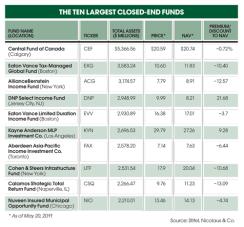Each day, RiverNorth Capital Management’s algorithmic trading model trolls the universe of closed-end mutual funds. In search of alpha, it estimates the funds’ discounts to their net asset values, making trades when those discounts meet the Chicago firm’s parameters. “In the closed-end space, you know the intrinsic value on a daily basis and what people are paying for it,” says Patrick Galley, CIO of $1 billion RiverNorth, which has roughly $500 million in closed-end funds through its hedge fund and two open-end mutual funds. “If you can buy a diversified pool of assets at a 15 percent discount, that’s a good value.” RiverNorth isn’t the typical patron of closed-end funds — mutual funds that raise capital, trade like stocks and invest in everything from equities to municipal bonds. Often taking on leverage to goose returns — though it sometimes magnifies losses — these 625-odd funds tend to trade at a discount or premium to their NAVs.
Closed-end funds are generally regarded as a retail product. Galley estimates that institutions, usually looking to unlock value, account for just 10 to 15 percent of the funds’ $210 billion market capitalization. But the asset class has attracted savvy investors like James Simons’ Renaissance Technologies and the Yale University endowment.
Picking a discounted fund and hoping the gap will narrow is not a proven winning strategy, because closed-end funds typically trade at a discount for good reason. Some investors won’t pay the NAV for the volatility related to a fund’s leverage. And with some closed-end bond funds, the yield on NAV is low compared with similar investments, so the discount boosts the effective yield. “It is not as easy as saying, ‘If it is trading at a discount, there is good value, and if it is trading at a premium, there is bad value,’” notes Jon Maier, a New York–based closed-end fund analyst for Bank of America Merrill Lynch.
Eliminating the gap requires a catalyst. For example, since the $1.88 billion NFJ Dividend, Interest & Premium Strategy Fund tripled its quarterly dividend late last year, its discount has narrowed by about 1,100 basis points, while its NAV has risen by just 20 basis points.
Closed-end municipal bond funds are trading at premiums these days because they have attractive yields and low leverage. Discounts can also narrow when activists like Phillip Goldstein of Saddle Brook, New Jersey–based Bulldog Investors try to persuade shareholders to convert to an open-end fund, which would immediately result in the fund trading at NAV, unlocking the discount. In 2009, Goldstein did that with what is now called the Special Opportunities Fund.
Many investors prefer to buy closed-end funds when the discount widens and approaches its historical high. “The excess risk disappears when the discount is as big as it can get,” says Alexander Reiss, senior analyst at St. Louis–based investment bank Stifel, Nicolaus & Co.
Another lure for institutions is their trading edge over the retail crowd. With municipal bond funds, for instance, a retail investor may just look at discounts and premiums or be spooked by talk of defaults, while a professional investor can examine a fund’s portfolio. “There are huge inefficiencies and a huge informational advantage for institutions,” Reiss says.
Closed-end funds also offer discount exposure to top managers. Charles Clough, CEO of Boston-based Clough Capital Partners and ex–chief global investment strategist at Merrill Lynch & Co., runs $2.1 billion in three such funds trading at double-digit discounts. And as Reiss points out, the $321 million Boulder Total Return Fund is a back door into Berkshire Hathaway — shares of Warren Buffett’s firm make up 40 percent of its assets — at a discount in the high teens. “Highly experienced, well-known managers may make institutions more comfortable holding positions in light of the fact the closed-end market is less liquid than other areas,” Reiss says.








